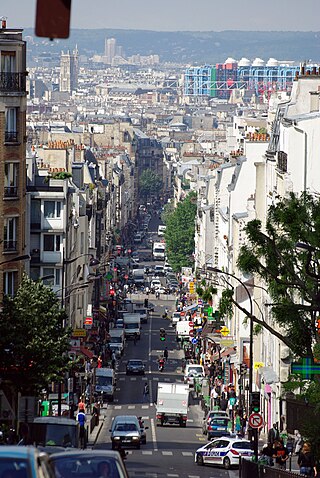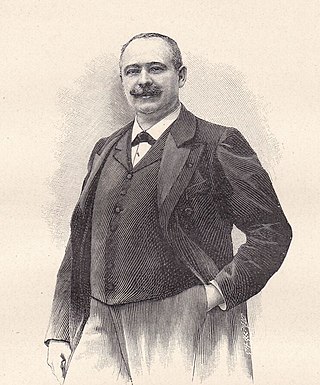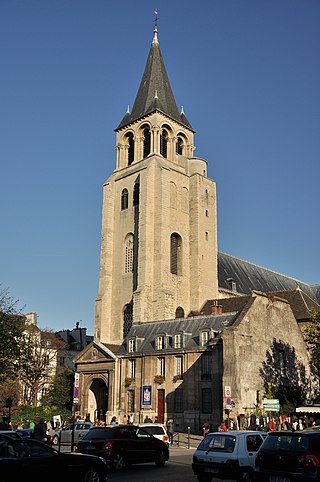
The 2nd arrondissement of Paris is one of the 20 arrondissements of the capital city of France. In spoken French, this arrondissement is colloquially referred to as deuxième. It is governed locally together with the 1st, 3rd and 4th arrondissement, with which it forms the 1st sector of Paris.

The Palais-Royal is a former French royal palace located on Rue Saint-Honoré in the 1st arrondissement of Paris. The screened entrance court faces the Place du Palais-Royal, opposite the Louvre. Originally called the Palais-Cardinal, it was built for Cardinal Richelieu from about 1633 to 1639 by architect Jacques Lemercier. Richelieu bequeathed it to Louis XIII, before Louis XIV gave it to his younger brother, Philippe I, Duke of Orléans. As the succeeding Dukes of Orléans made such extensive alterations over the years, almost nothing remains of Lemercier's original design.

The Rue du Faubourg Saint-Honoré is a street located in the 8th arrondissement of Paris, France. Relatively narrow and nondescript, especially in comparison to the nearby Avenue des Champs-Élysées, it is cited as being one of the most luxurious and fashionable streets in the world thanks to the presence of virtually every major global fashion house, the Élysée Palace, the Hôtel de Pontalba, the Embassy of Canada, the Embassy of the United Kingdom, as well as numerous art galleries.

The following is a timeline of the history of the city of Paris, France.

Rue de Ménilmontant is a street which runs through the 20e arrondissement of Paris, France.

Bernard Auguste Rives, known as Gustave Rives (1858–1926), was a French architect of the late 19th and early 20th centuries who designed residential, institutional, and commercial buildings in France in a style described as "opulent eclecticism." He organized many popular auto and aeronautical shows in Paris before the First World War.

The Galerie Véro-Dodat is one of the covered passages of Paris. It is located in the 1st arrondissement, connecting the Rue de Jean-Jacques Rousseau and Rue de Croix-des-Petits-Champs. It was built in 1826.

The Galerie Vivienne is one of the covered passages of Paris, France, located in the 2nd arrondissement. It is 176 metres (577 ft) long and 3 metres (9.8 ft) wide. The gallery has been registered as a historical monument since 7 July 1974.

Passage Choiseul is one of the covered passages of Paris, France located in the 2nd arrondissement. It is the continuation of Rue de Choiseul.

The city of Paris has notable examples of architecture of every period, from the Middle Ages to the 21st century. It was the birthplace of the Gothic style, and has important monuments of the French Renaissance, Classical revival, the Flamboyant style of the reign of Napoleon III, the Belle Époque, and the Art Nouveau style. The great Exposition Universelle (1889) and 1900 added Paris landmarks, including the Eiffel Tower and Grand Palais. In the 20th century, the Art Deco style of architecture first appeared in Paris, and Paris architects also influenced the postmodern architecture of the second half of the century.
Rue du Cloître-Saint-Benoît was a now-disappeared street in the Sorbonne district of Paris, demolished to build the present rue des Écoles. It was named after the cloister of the église Saint-Benoît-le-Bétourné and just before the French Revolution it fell within that church's parish. It was made part of the Chalier sector during the Revolution - that sector was renamed the Sorbonne district when the original 11th arrondissement of Paris was formed in 1795.

Le Dit des rues de Paris is a 554-verse poem in octosyllabic rhyming couplets, written by Guillot of Paris and describing the streets of Paris between around 1280 and 1300. It deals with 310 streets, organised into the city's three main districts at that time:

The Rue Coquillière is one of the oldest paths of the 1st arrondissement of Paris, France.

The Rue de l'Université is a street located in the 7th arrondissement of Paris, France.

The Convent of Our Lady of Calvary, also named Convent of the Filles du Calvaire, is a former Roman Catholic convent in Paris, France.

Saint-Denis de La Chartre was a Roman Catholic church building located on the Île de la Cité in Paris, France. It was demolished in 1810.

The Rue Beaujolais is a street in the 1st arrondissement of Paris, France.

The Rue Croix-des-Petits-Champs is a street in the 1st arrondissement of Paris, France.

The expansion of the Louvre under Napoleon III in the 1850s, known at the time and until the 1980s as the Nouveau Louvre or Louvre de Napoléon III, was an iconic project of the Second French Empire and a centerpiece of its ambitious transformation of Paris. Its design was initially produced by Louis Visconti and, after Visconti's death in late 1853, modified and executed by Hector-Martin Lefuel. It represented the completion of a centuries-long project, sometimes referred to as the grand dessein, to connect the old Louvre Palace around the Cour Carrée with the Tuileries Palace to the west. Following the Tuileries' arson at the end of the Paris Commune in 1871 and demolition a decade later, Napoleon III's nouveau Louvre became the eastern end of Paris's axe historique centered on the Champs-Élysées.



















